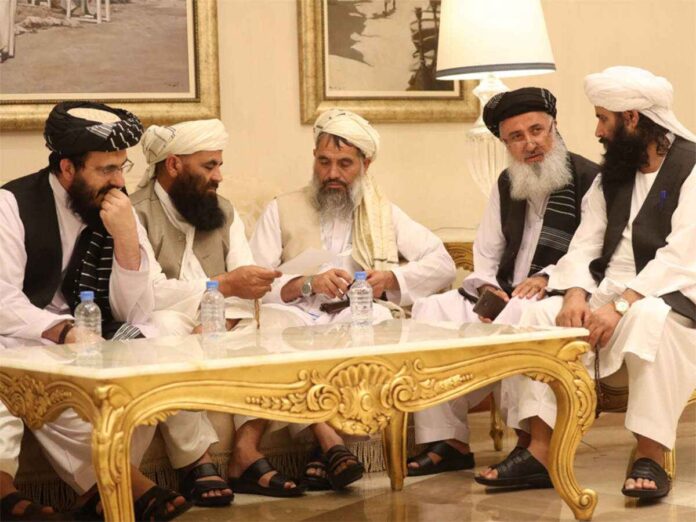Indo-Afghan bonhomie has seen many ups and downs. India’s friendship with Afghanistan is ostensibly actuated by altruism. But, deep down, it is the upshot of antipathy to the Taliban and Pakistan that India regards as the Taliban’s mentor.
Through diplomatic maneuvering and machinations, India did its best to isolate Afghanistan from Pakistan. It is eerie that India has no common border with Afghanistan, yet it has always tried tooth and nail to create a foothold in Afghan affairs.
Like India, the USA, too, had been constantly changing its foreign policy towards Afghanistan.
Initially, the US Air Force used to rush quickly to rescue the Afghan forces it trained. But they then began to ignore the Afghan SOS calls. The situation took such a grim turn that the Taliban used to “breakfast” with 20 to 40 casualties of the Afghan forces each day. The USA ignored faults with the Afghan army. They knew that the actual strength of the Afghan army was never more than 200,000, but the government inflated it to 300,000. The figures were inflated to devour funds and rations. There was no coordination plan or battle strategy to defeat the Taliban foot soldiers numbering about 25,000 to 30,000. The Afghan troops owed their allegiance to the governors or political figures in their homeland rather than their senior commanders. Once the governors capitulated, the Afghan troops lost the will to fight.
Some retired Indian officers, including Maj Gen (retd) SP Sinha, even allege that it is well nigh impossible that the Afghan forces surrendered without US connivance. Sinha alleges that the USA “instructed” the Afghan forces to surrender. It did so to drag China in the Afghan imbroglio. The USA wants to bleed China in “the graveyard of empires”.
Following the East Pakistan debacle (1971), `Pakistan developed a doctrine of “strategic depth.” The idea is`to have a secure refuge in the case of a future war with India. The porous border offers a route by which Pakistani leaders, troops and other assets, including its nuclear weapons, could retreat to the northwest in the case of an Indian invasion’ (William Dalrymple, A Deadly Triangle: Afghanistan, Pakistan, and India) India believes the myth that it is cornerstone of Pakistan’s military strategy to keep the Taliban under its sway. That is how Pakistan’s “strategic depth” could be maintained in case of a military conflict with India regards the Taliban of all shades as Pakistani stooges. India’s antipathy to the Taliban is obvious from India never recognising the Taliban’s short-lived government of 1996. It had earlier been the only South Asian country to recognise the Soviet-backed Democratic Republic of Afghanistan.
When the Northern Alliance took over the Afghan government, after the collapse of the Taliban, India quickly recognised it. India then boasted that the “strategic depth” Pakistan had yearned for, had evaporated overnight.
The way India hastily vacated its consulates in Afghanistan portends that India would take such steps as would offend the nascent Taliban 2.0 government.
After the Taliban’s ouster, India began to bolster its cooperation with successive Afghan governments. India provided Afghanistan $650-750 million in “humanitarian” and economic aid. India became the largest regional aid donor
In the guise of infrastructural projects, India kept trying to deepen its influence in the Afghan government. It initiated a mining project while recruiting Afghans to carry out sabotage inside Pakistan. The scale of India’s investment in Afghanistan’s development is stupendous. It built over 200 public and private schools, sponsored over 1000 scholarships, besides building many bridges, roads and small dams.
In 2011, India signed a strategic–partnership agreement with Afghanistan to further boost mutual relations. The second Strategic Partnership Council meeting was held in New Delhi on 11 September 2017. Making use of the fresh $1 billion development assistance announced India, the vwo launched a ‘New Development Partnership’. India agreed to implement important new projects such as the Shahtoot Dam and drinking water project for Kabul that would also facilitate irrigation; water supply for Charikar City; road connectivity to Band-e-Amir in Bamyan Province to promote tourism; low-cost housing for returning refugees in Nangarhar Province; a gypsum board manufacturing plant in Kabul; and a polyclinic in Mazar-e-Sharif among others.
Besides, India outlined 116 High Impact Community Development Projects in 34 provinces. These projects were in a broad range including education, health, agriculture, irrigation, drinking water, renewable energy, flood control, micro-hydro power, sports and administrative infrastructure.
India also announced that on-going assistance programmes for education, capacity building, skills and human resource development of Afghanistan, would continue for five more years to 2022.
Since its 2017 inauguration, the India-Afghanistan Air-Freight Corridor has witnessed close to 1000 flights, carrying goods valued at over $216 million. It provided a boost to Afghan exports to India and has benefited Afghan farmers and small traders and exporters. India and Afghanistan now aim to expand the Corridor to other cities in both countries.
Another important initiative was the operationalization of the Chabahar Port in December 2017, followed by a commercial port management agreement in February 2018. The Port has so far handled over 5,000 containers ferrying over 110,000 tons of wheat and over 2,000 tons of pulses sent by India as assistance to Afghanistan via Chabahar. These were delivered to various parts of Afghanistan and average transportation time was under two weeks. In 2019, Afghanistan shipped around 700 tons of agricultural and mineral products to India through Chabahar.
An average of over 3,500 Afghan nationals underwent training/education in India every year. More than 15,000 Afghan students went to India on self-financing basis.
India helped Afghanistan rebuild power infrastructure including the 220KV DC-transmission line from Pul-e-Khumri, capital of Baghlan province. Telecommunications infrastructure in many Afghan provinces were also been restored by India.
India has also gifted Afghanistan 400 buses and 200 mini-buses for urban transportation. This is in addition to 105 utility vehicles of municipal operations and 285 military vehicles. India also donated military helicopters and other aircraft.
Most of the above-mentioned assets have been captured by the Taliban. However, the possibility of losing a key strategic ally in South Asia may surpass concerns for its $3 billion investment.
India plumes itself for having cooperated in Afghanistan’s development, but also tries to vilify the Taliban by alleging that Pakistani militant groups have infiltrated its rank and file. India’s External Affairs Minister S. Jaishanker made many veiled attacks on the Taliban and Pakistan in his speech before the UN Security Council.
He pointed to the delay in designating terrorist individuals, entities. Without directly identifying Pakistan, he also referred to states “clearly guilty of aiding and supporting terrorism, and willfully provide financial assistance and safe havens”.
“Counter Terrorism is a priority area for India during this term and [it] looks forward to contributing to the meeting that seeks not only to identify emerging trends but to also laying the groundwork for common priorities that would shape the future multilateral action in the domain of Counter Terrorism,” sources said, explaining the context of the speech.
India was offered to chair three important committees including the Taliban sanctions committee, the counter-terrorism committee and the Libya sanctions committee during its tenure at the UNSC.
By accepting the Taliban-sanctions committee’s chairmanship, India made it clear it would continue to make mischiefs against the Taliban. Its hostility is conspicuous from the FIRs filed against persons expressing jubilation at the Taliban’s victory.
Samajwadi Party MP Shafiqur Rehman Barq was booked for sedition for defending the Taliban’s takeover of Afghanistan and equating it with India’s own freedom struggle. He was charged following a complaint from BJP leader Rajesh Singhal .
The MP has been also booked under sections 153A (promoting enmity between different groups on grounds of religion, race, place of birth, residence, language) and 295A (deliberate and malicious acts, intended to outrage religious feelings of any class by insulting its religion or religious beliefs). Barq had called the Taliban a force that did not allow Russia or the USA to establish themselves in Afghanistan, “and now they want to run their own country”. The MP had said that when India was under British Rule, the entire country fought for independence.
“They want to be free. This is their personal matter. How can we interfere?” the SP legislator had said on developments in Afghanistan. Endorsing the Taliban takeover, Barq had said the Afghans want to run their own country in the manner they wanted.” The remarks drew sharp criticism from UP CM Yogi Adityanath. In the state legislative council, he on Tuesday slammed the opposition MP. The chief minister said, ‘He was shamelessly supporting the Taliban. It means supporting their barbaric act.’.
India has no border with Afghanistan. Yet it created its own brand of mujahideen belonging to the Northern Alliance. India not only provided multi-faceted aid to the Alliance but even trained Northern Alliance fighters.
The support involved helicopters, ordnance, mortars, small armaments, refurbished Kalashnikovs seized in Kashmir, combat and winter clothes, packaged food, medicines, and funds. These supplies were delivered circuitously with the help of other countries (like Tajikistan) or through Massoud’s brother Wali in London.
India opened four consulates at Kandahar, Jalalabad, Herat and Mazar-e-Sharif, besides its embassy at Kabul. It pampered Ahmad Shah Massoud as its protégé for use on the Afghan chessboard as and when circumstances allowed. India is still using these consulates to stoke up secessionist movements in Balochistan and the volatile tribal belt.
The way India hastily vacated its consulates in Afghanistan portends that India would take such steps as would offend the nascent Taliban 2.0 government.
























Afther listing the great work done by India in building Afghanistan, this writer is jovially suggesting “Most of the above-mentioned assets have been captured by the Taliban”. Will such shameless writer explain to world as to what Taliban will do with the assets, which are provided/ build by India for Afghanistan? Will Taliban use or destroy them or gift them to Pakistan? Analize and understand that Taliban can’t do anything with ‘such assets’ except using them for the benefit of normal Afghan polulation, or else for destruction of their own goodwill in the eyes of Afghan nationals.
As regards to infiltration of Pak Regulars and Jiyallas in Taliban fighters, it is not India but all in world are recognizing it. Even PMIK tacitly admitted it suggesting that Pakistan doesn’t know which Afghan refugee returning to Afghanistan is Taliban? Pakistan even not denied the reports of Pak regulars I-Cards or killings in Afghanistan. The writer probably has not even witnessed the UNSC proceeding, hence fail to understand that UNSC Chair has no major role to play in its proceedings. As regards to closed consulates this idiot is suggesting that India is still using them ‘to stoke up secessionist movements in Baluochistan’. Pathetic blabbers of obsession about India. 😏